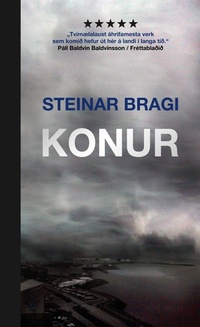Konur / Women
“For every woman who takes a seat in parliament, or as a managing director, or ‘shames’ men in other ways by gaining access to power, thousands of porn movies are produced which put women back in ‘their place,’ where they are powerless, submissive, and usually humiliated.”
 Steinar Bragi has commented in interviews that in his fifth novel Konur/Women he was trying to get in touch with his inner misogynist. The book was being talked about even at the manuscript stage: the rumour spread that a groundbreaking work of Icelandic literature was on the way, long before Women was published at the end of 2008.
Steinar Bragi has commented in interviews that in his fifth novel Konur/Women he was trying to get in touch with his inner misogynist. The book was being talked about even at the manuscript stage: the rumour spread that a groundbreaking work of Icelandic literature was on the way, long before Women was published at the end of 2008.
The novel is about Eva Einarsdóttir, a young woman who returns home to Iceland after living in New York. She has been offered a rent-free apartment in a hi-tech high-rise with state-of-the-art security and monitoring in downtown Reykjavík. Eva has come “home” to a country which is unrecognisable. Seamen and the fisheries has given way to traders and securities, and glass skyscrapers have replaced modest houses clad in corrugated iron. Women depicts Iceland in the moments before the crash, when fantasies of Reykjavík as a financial powerhouse at the edge of the world reached their dizziest heights of madness. Steinar Bragi challenges the extremes of capitalism and profiteering, where human values are discarded in favour of the superficial and amoral.
But it is also, obviously, a book about women: how women become commodities in the neo-libertarian world where everything has its price. As the artist in the book says; “For every woman who takes a seat in parliament, or as a managing director, or ‘shames' men in other ways by gaining access to power, thousands of porn movies are produced which put women back in 'their place,' where they are powerless, submissive, and usually humiliated.” Eva has everything she could possibly want in her apartment; but it transpires that her home is far from being the Garden of Eden from which that other Eve was expelled. The book comprises two parts, entailing a certain dialectic: the first half slides over the shiny surface of the “boom” society, while in the latter half the author delves beneath the surface into a surrealistic nightmare, where Eva becomes part of a savage work of modern art.
In Women Steinar Bragi returns to themes from his earlier works, where the environment of Reykjavík, Iceland's capital, is depicted with a weirdness verging on the sinister. He has explained his uncomfortable relationship with language: how a certain repugnance is an unavoidable part of the creative process, as he must coerce his subjective ideas into written form. And this uneasy relationship may be seen as emerging in the underlying ambiance of menace in Konur and his previous writings. The sense of menace intensifies as the work progresses, culminating in the excruciating second half.
With this social and cultural polemic, Steinar Bragi raises a much-needed voice of protest against the madness that reigned in Iceland until the rude shock of the economic meltdown of October 2008.
.jpg)